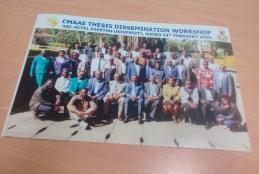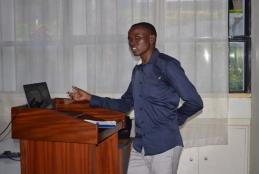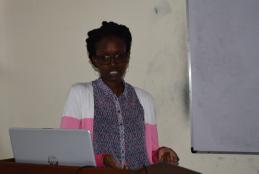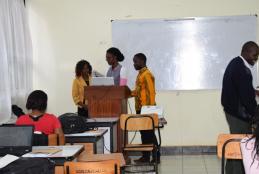Latest News & Announcements
The Role That the Adoption of Climate-Smart Agricultural Technologies (CSAT) Could Play As Potential Remedies To Build Farmer’s Resilience Against Climate Change In Kalehe Territory Of DRC.
Kalehe Territory in South-Kivu Province of Democratic Republic of Congo (DRC)suffers from food insecurity, malnutrition, and poverty because of many factors including climate change. Of the 26 Provinces in the DRC, South-Kivu Province leads with the highest proportion of stunted children under five at 53%. Within South-Kivu Province, Kalehe Territory leads in the prevalence of chronic malnutrition prevalence at 66%, far exceeding the provincial average of 53%.
A Rwandese ,Benimana Uwera Gilberthe On Impact of Hermetic Storage Technology Adoption on Smallholder Maize Farmers’ Income in Gatsibo District, Rwanda
The growing food demand occasioned by the rising global population is emerging a major issue of global concern. This implies that food production needs to increase in order to meet global food demand. Studies show that more than one-third of the global food production is lost through post harvest operations along food supply chain.
ROLE OF INFORMATION COMMUNICATION TECHNOLOGIES (ICTs) IN ACCESSING INFORMATION ON BEST AGRONOMIC PRACTICES AMONG SMALLHOLDERs TOMATO FARMERS IN KIRINYAGA COUNTY
Stephen Waitugi says tomato farming is of a significant economic importance in Kenya as it is one of the key enterprises among small-holder farmers. However, despite the economic importance, the sector still faces numerous challenges. This includes agronomic challenges such as pests and diseases and physiological disorders, poor post-harvest technologies and institutional constraints such as lack of access to credit and poorly organized rural and urban market infrastructures that permit unpredictable price fluctuation.
Interested in Knowing the Impact of Rice Importation on Liberia's Economy ?Meet Mathew Koyeamai ,a noted Agrieconomist Elaborate it all.
This study analyzes the impact of rice importation on the exchange rate, inflation, and GDP in Liberia. It seeks to unearth the contribution of rice importation to the economic perils facing the country, which is visible by the continuous depreciation of the country’s currency, the continuous rising of the general price level, and the slum in the total output of the country.
Use of Climate Information Services and Impact on Farmers’ Livelihoods in Arid and Semi-Arid Areas of Kenya As Researched by Njoki Wango,A PhD Student in the Department.
Agricultural production in Africa is mainly rain fed and highly vulnerable to climate change and variability. Extreme weather events like droughts, floods and high temperatures affect agricultural production and food security. Use of climate information services can have positive effect on agricultural yields, household incomes, food security, poverty reduction and enhance resilience against climate risks.
Passion For Agricultural Economics Drives Vincent Gadamba Misingo All the Way to Rwanda to Research on Impact Of Insect Pest Control Push-Pull Technology On Smallholder Maize Productivity In The Eastern Province Of Rwanda.
Maize is one of the food and commercial crop in Rwanda in terms of income generating activity to rural population. The production of the crop is however, severely constrained by both biotic and abiotic factors. Biotic factors specifically field pests namely fall armyworm (FAW) and Stemborer (SB) pests are ranked top in causing economic damages to maize production in Rwanda. Up to 23-50 percent of food supply in Rwanda is lost due to pest infestation.
Perceptions and Preferences for Insect-Based Chicken Feeds Analysis in Kiambu County by Afrika Okello Onguko
Poultry feed accounts for 60 to70 percent of the costs of poultry production due to expensive protein ingredient that is a key component. Expensive feed has seen poultry farmers scale down production or abandon the enterprise despite the currently high and projected increased demand for poultry products. Insects like the black soldier fly larvae (BSFL) have been identified as the best alternative source of protein for poultry feeds.
Togba V. Sumo A Liberian Scholar Talks About smallholder farmers’ perception, access to extension services and willingness to pay for integrated pest management strategy: the case of Margibi County, Liberia
The low productivity of the agricultural sector in Liberia raises serious concern and motivates the search for the various factors explaining the poor performance. Poor performance of the extension system and loss of attainable crop yields to insect pests by the smallholder farmers are two key factors likely to explain the unsatisfactory performance of the agricultural sector.
Analysis Of Dairy Innovations And Their Contribution To Dairy Farmers’ Welfare In Selected Counties Of Kenya as Reported By Edith Warigia Wairimu, a Brilliant Postgraduate Student of Agricultural Economics
The Kenyan dairy subsector has a potential of improving household income and reducing poverty among dairy farmers through provision of regular income from milk sale. The subsector is however faced with various challenges including low milk yields per cow, seasonal fluctuations in milk availability and prices with reduced production levels during dry season, adulteration, fragmentation of milk production between small farms, milk collection costs, high level of antibiotics in milk, presence of aflatoxin M1 in milk and high level of microbial load among other challenges.





